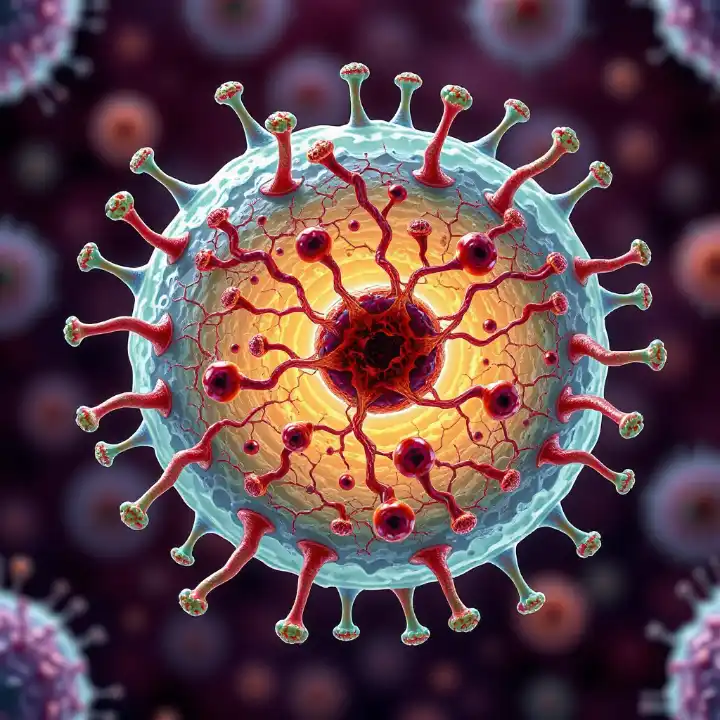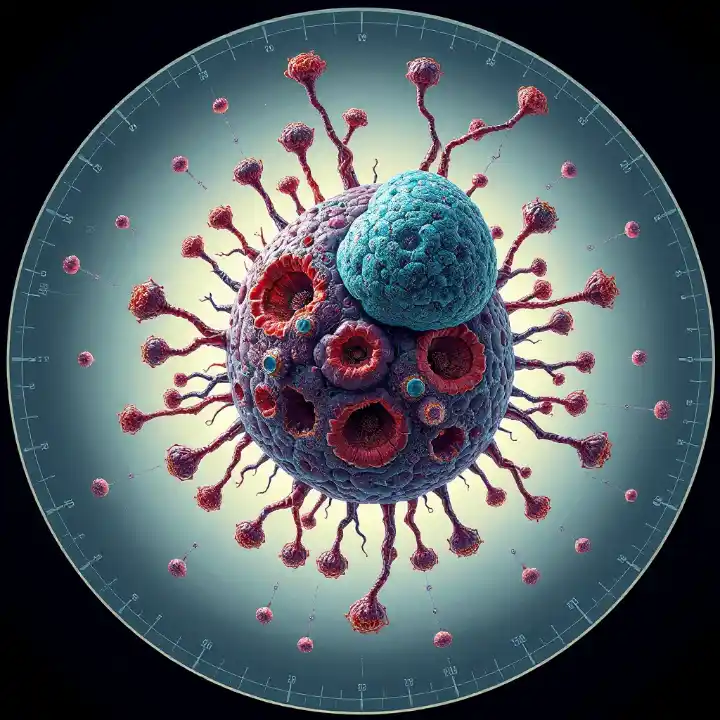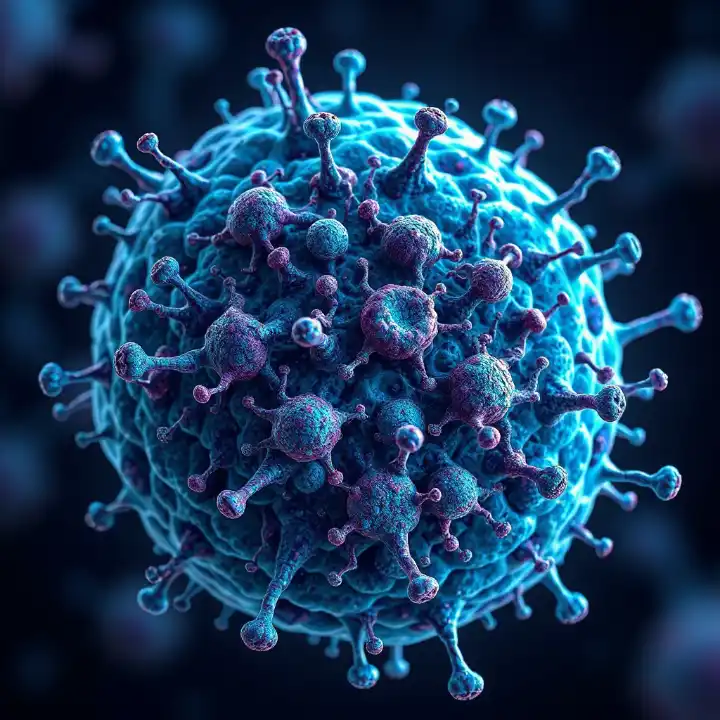Understanding Thymoma and Thymic Carcinoma Symptoms and Causes

Thymoma and thymic carcinoma are rare cancers that develop in the thymus gland, a small organ located in your chest behind the breastbone. 🧬Learn About Every Cancer Type. These conditions are uncommon, with thymic tumors affecting approximately 1.3 to 2.8 people per million annually in the United States. This translates to around 400 new cases each year. Although rare, these cancers can cause serious health issues if left untreated. Recognizing early symptoms, such as chest pain or persistent cough, can help you seek timely medical care. Early detection improves treatment outcomes and may prevent complications.
Key Takeaways
Know the early signs of thymoma and thymic cancer. These include chest pain, coughing a lot, and trouble breathing. Finding it early can help with better treatment.
Learn how autoimmune diseases, like myasthenia gravis, connect to thymoma. If you have one, watch for related symptoms.
See a doctor if you notice unusual symptoms. Getting help quickly is important for proper care.
Understand how genetic changes affect thymic cancers. Knowing your family’s health history can show your risk.
Look into treatments like surgery, radiation, or chemotherapy. Talk to your doctor to choose the best plan for you.
Symptoms of Thymoma and Thymic Carcinoma

General Symptoms
Thymoma and thymic carcinoma often present with symptoms that can be mistaken for other conditions. You might experience:
Chest pain or a feeling of pressure in your chest.
A persistent cough that doesn’t improve over time.
Shortness of breath, especially during physical activity.
These symptoms occur because the tumor may press on nearby structures in your chest. If you notice any of these signs, it’s important to consult a healthcare provider.
Symptoms Related to Paraneoplastic Syndromes
Paraneoplastic syndromes are conditions caused by your immune system reacting to the tumor. These syndromes often accompany thymoma and thymic carcinoma. Common examples include:
Paraneoplastic Syndrome | Symptoms |
|---|---|
Muscle weakness, drooping eyelids, double vision, fatigue | |
Pure red blood cell aplasia | Anemia, leading to fatigue and dizziness |
Frequent infections, diarrhea, swollen lymph nodes |
Myasthenia gravis is the most common syndrome linked to thymoma. If you experience muscle weakness or frequent infections, these could be signs of an underlying issue.
Advanced Symptoms
In advanced stages, thymoma and thymic carcinoma can cause more severe symptoms. You might notice:
Difficulty swallowing, which can make eating or drinking uncomfortable.
Swelling in your face, neck, or upper body, often due to superior vena cava syndrome.
Hoarseness or changes in your voice, which may result from nerve involvement.
These symptoms suggest that the tumor has grown or spread, affecting nearby tissues and blood vessels. Seeking medical attention promptly can help manage these complications.
Causes and Risk Factors of Thymoma and Thymic Carcinoma
Known Causes
Genetic mutations in thymic cells
Genetic mutations play a significant role in the development of thymoma and thymic carcinoma. Researchers have identified several mutations commonly associated with these cancers, including:
HRAS
NRAS
TP53
GTF2I
Among these, the GTF2I L424H mutation stands out as the most frequent in thymic epithelial tumors. Studies show that this mutation can trigger thymic tumors in genetically engineered mice, highlighting its importance in the disease's progression. Understanding these genetic changes helps scientists develop targeted therapies for thymic cancers.
Inherited conditions (e.g., MEN1 syndrome)
Certain inherited conditions, like multiple endocrine neoplasia type 1 (MEN1) syndrome, may increase your risk of developing thymoma and thymic carcinoma. MEN1 syndrome causes tumors in endocrine glands, including the thymus. If you have a family history of MEN1, discussing your risk with a healthcare provider is essential.
Associated Risk Factors
Autoimmune conditions (e.g., myasthenia gravis, lupus)
Autoimmune disorders often accompany thymoma and thymic carcinoma. Conditions linked to these cancers include:
Myasthenia gravis
Lupus erythematosus
Rheumatoid arthritis
Polymyositis
Thyroiditis
Sjögren syndrome
Myasthenia gravis is the most common autoimmune condition associated with thymoma. If you have an autoimmune disorder, monitoring your health for related symptoms is crucial.
Age and gender (more common in middle-aged adults)
Age and gender influence your likelihood of developing thymoma and thymic carcinoma. These cancers typically occur between the ages of 40 and 60. Type B1 and B2 thymomas are more common in younger individuals, while type A thymomas and thymic carcinomas often affect older adults. Gender differences also exist, with certain thymoma subtypes being slightly more prevalent in men or women.
Environmental or occupational exposures (e.g., prolonged exposure to certain chemicals or radiation)
Exposure to harmful chemicals or radiation may increase your risk of thymoma and thymic carcinoma. While specific environmental factors remain under investigation, reducing exposure to known carcinogens can help lower your overall cancer risk.
Diagnosis of Thymoma and Thymic Carcinoma
Initial Evaluation
Physical examination and medical history
Diagnosing thymoma and thymic carcinoma begins with a thorough physical examination and review of your medical history. Your doctor will check for general signs of health and any unusual findings, such as swelling or tenderness in the chest area. This step helps identify potential symptoms and risk factors related to these cancers.
Imaging tests (e.g., chest X-ray, CT scan)
Imaging tests play a crucial role in the initial evaluation. Commonly used imaging methods include:
Chest X-ray: This test provides a basic view of your chest, helping detect masses or abnormalities.
CT scan: A more detailed imaging technique that creates cross-sectional pictures of your chest. It is often the primary test used to identify thymic tumors.
MRI: This test uses magnets and radio waves to produce detailed images of soft tissues, helping differentiate thymoma from other growths.
These imaging techniques allow doctors to assess the size, location, and extent of the tumor.
Confirmatory Tests
Biopsy (needle biopsy or surgical biopsy)
A biopsy confirms the diagnosis by analyzing a sample of the tumor. A needle biopsy, such as fine-needle aspiration, involves extracting cells using a thin needle. This method is less invasive but may not provide enough tissue for a definitive diagnosis. In contrast, a surgical biopsy involves removing part or all of the tumor during surgery. This approach is often used when more comprehensive tissue analysis is needed.
Blood tests (to check for paraneoplastic syndromes)
Blood tests help identify paraneoplastic syndromes associated with thymoma and thymic carcinoma. These tests include:
Test Type | Findings and Implications |
|---|---|
Complete Blood Cell Count (CBC) | May reveal anemia or other abnormalities linked to cancer or autoimmune conditions. |
Autoantibody Assays | Detect autoantibodies associated with paraneoplastic syndromes, aiding in diagnosis. |
Protein Electrophoresis | Identifies changes in protein levels, often seen in autoimmune disorders. |
These tests provide valuable insights into how the tumor affects your immune system and overall health.
Staging the Cancer
TNM staging system (tumor size, lymph node involvement, metastasis)
Doctors use the TNM staging system to classify thymoma and thymic carcinoma. This system evaluates:
T (Tumor): The size and extent of the primary tumor.
N (Nodes): Whether cancer has spread to nearby lymph nodes.
M (Metastasis): Whether cancer has spread to distant organs.
For example, Stage I includes small tumors confined to the thymus, while advanced stages involve larger tumors or metastasis.
Additional imaging (e.g., PET scan, MRI)
Additional imaging tests, such as PET scans, help stage the cancer more accurately. A PET scan uses a radioactive sugar to highlight cancer cells, providing a detailed view of tumor activity. Combining PET with CT scans offers a comprehensive assessment of the cancer's spread.
Treatment Options for Thymoma and Thymic Carcinoma

Surgery
Thymectomy (removal of the thymus gland)
Surgery is often the first-line treatment for thymoma and thymic carcinoma. A thymectomy, which involves removing the thymus gland, is the most common surgical procedure. This approach is highly effective for early-stage thymomas. The success rates of thymectomy vary depending on the condition and stage of the disease.
Condition | 5-Year OS Rate | 10-Year OS Rate | |
|---|---|---|---|
Thymic Carcinoma | 78% | N/A | N/A |
Thymoma | 86% | 77% | 59% |
The table above highlights the overall survival (OS) rates after thymectomy. If you undergo surgery for thymoma, your chances of long-term survival are significantly higher compared to thymic carcinoma. Early detection and surgical intervention improve outcomes.
Radiation Therapy
When used post-surgery or for inoperable tumors
Radiation therapy plays a critical role in treating thymoma and thymic carcinoma, especially when surgery is not an option. Doctors may recommend radiation therapy in the following scenarios:
Treatment Context | Recommendation |
|---|---|
Clearly resectable well-defined disease | Surgical resection is often the initial intervention. |
Clinically borderline or unresectable lesions | Neoadjuvant chemotherapy, thoracic radiation therapy, or both may be used. |
Locally advanced disease | Multimodality therapy is evaluated. |
Operable thymic carcinoma | Surgery followed by postoperative radiation therapy (PORT) with or without chemotherapy. |
Inoperable thymic carcinoma | Options include chemotherapy, chemoradiation therapy, or chemotherapy followed by surgery and radiation therapy. |
Radiation therapy is often used after surgery to eliminate any remaining cancer cells. For inoperable tumors, it can help shrink the tumor and relieve symptoms. Your doctor will determine the best approach based on the tumor's size and location.
Chemotherapy
Common drugs used for thymic carcinoma
Chemotherapy is another important treatment option, particularly for advanced thymic carcinoma. It involves using drugs to kill cancer cells or stop their growth. The most commonly used chemotherapy regimens include:
Regimen | Components |
|---|---|
First-line | Carboplatin and Paclitaxel |
Combination | Cisplatin, Doxorubicin, Cyclophosphamide, Vincristine |
Additional | Carboplatin and Paclitaxel, Pemetrexed and Irinotecan with Cisplatin or Carboplatin |
ADOC | Doxorubicin, Cisplatin, Vincristine, Cyclophosphamide |
PE | Cisplatin and Etoposide |
Ifosfamide | Ifosfamide with Cisplatin and Etoposide |
Second-line | Etoposide, Ifosfamide, Pemetrexed, Gemcitabine, Paclitaxel, Sunitinib, Everolimus, Lenvatinib, Pembrolizumab |
Your doctor may recommend a specific regimen based on the stage and type of cancer. For thymic carcinoma, first-line treatments like Carboplatin and Paclitaxel are often used. Second-line therapies, such as Pembrolizumab or Everolimus, may be considered for advanced cases.
Targeted Therapy and Immunotherapy
Emerging treatments for advanced cases
For advanced cases of thymoma and thymic carcinoma, targeted therapies and immunotherapies offer new hope. These treatments focus on specific aspects of cancer cells, aiming to slow their growth or enhance your immune system's ability to fight them.
Hormone Therapies: Octreotide (Sandostatin) is a hormone therapy that attaches to thymoma cells. It works by inhibiting their growth and may benefit some patients with advanced thymoma.
Targeted Therapy: Drugs like Everolimus, Sunitinib, and Lenvatinib target specific genes and proteins involved in cancer progression. These therapies aim to disrupt the pathways that allow cancer cells to grow and spread.
Immunotherapy: Pembrolizumab (Keytruda), a PD-1 inhibitor, shows promise for thymic carcinoma. It enhances your immune system's response, helping it recognize and attack cancer cells more effectively.
These emerging treatments are often used when traditional options like surgery or chemotherapy are not effective. Your doctor may recommend these therapies based on your cancer's stage and genetic profile.
Supportive Care
Managing symptoms of paraneoplastic syndromes
Paraneoplastic syndromes, often linked to thymoma and thymic carcinoma, can cause symptoms like muscle weakness or frequent infections. Managing these symptoms improves your quality of life. Treatments may include:
Medications: Drugs like corticosteroids or immunosuppressants can reduce inflammation and control autoimmune responses.
Physical Therapy: Exercises tailored to your needs can help improve muscle strength and mobility.
Nutritional Support: A balanced diet supports your immune system and overall health.
By addressing these symptoms, you can maintain better physical and emotional well-being during treatment.
Palliative care for advanced stages
In advanced stages, palliative care focuses on relieving symptoms and improving comfort. This care includes:
Pain Management: Medications or therapies to control pain caused by the tumor.
Breathing Support: Oxygen therapy or other interventions to ease shortness of breath.
Emotional Support: Counseling or support groups to help you and your family cope with the challenges of advanced cancer.
Palliative care ensures that you receive compassionate support tailored to your needs, helping you live as comfortably as possible.
Understanding thymoma and thymic carcinoma can help you recognize symptoms early and seek timely care. These cancers often cause persistent cough, chest pain, or shortness of breath. Symptoms may also include muscle weakness, anemia, or frequent infections due to associated autoimmune conditions. Diagnosing these cancers involves imaging tests, biopsies, and staging to determine the extent of the disease. Treatments like surgery, radiation, and chemotherapy offer effective options, while emerging therapies provide hope for advanced cases. Always consult a healthcare professional for personalized advice. If you notice any concerning symptoms, act promptly to protect your health.
FAQ
What is the difference between thymoma and thymic carcinoma?
Thymoma grows slowly and often remains confined to the thymus. Thymic carcinoma grows faster and spreads to other parts of the body. Both originate in the thymus gland but differ in behavior and treatment approaches.
Can thymoma or thymic carcinoma be cured?
Early-stage thymoma often responds well to surgery and has high survival rates. Thymic carcinoma is harder to treat but can be managed with a combination of therapies. Your doctor will recommend the best treatment plan based on your condition.
Are thymoma and thymic carcinoma hereditary?
Most cases are not hereditary. However, certain inherited conditions, like MEN1 syndrome, may increase your risk. If you have a family history of related conditions, discuss it with your healthcare provider.
How can I reduce my risk of developing thymic cancers?
You can lower your risk by avoiding harmful chemicals and radiation exposure. Regular check-ups and monitoring autoimmune conditions may also help detect issues early. Maintaining a healthy lifestyle supports overall well-being.
What should I do if I suspect symptoms of thymoma or thymic carcinoma?
Consult a healthcare provider immediately if you experience persistent chest pain, shortness of breath, or muscle weakness. Early diagnosis improves treatment outcomes. Your doctor may recommend imaging tests or a biopsy to confirm the diagnosis.
See Also
Exploring Symptoms And Causes Of Laryngeal Cancer
Hepatocellular Carcinoma: Symptoms And Key Information
Gallbladder Cancer: Recognizing Symptoms And Underlying Causes
Adrenocortical Adenoma: Symptoms And Available Treatment Options
